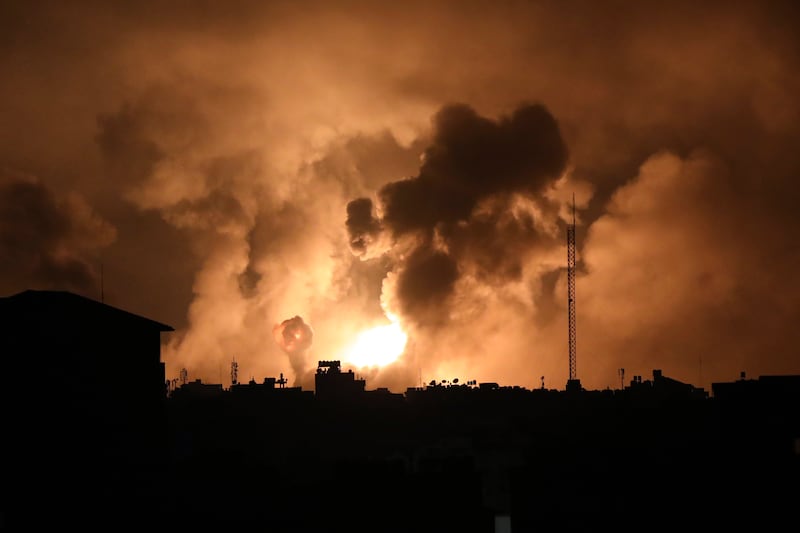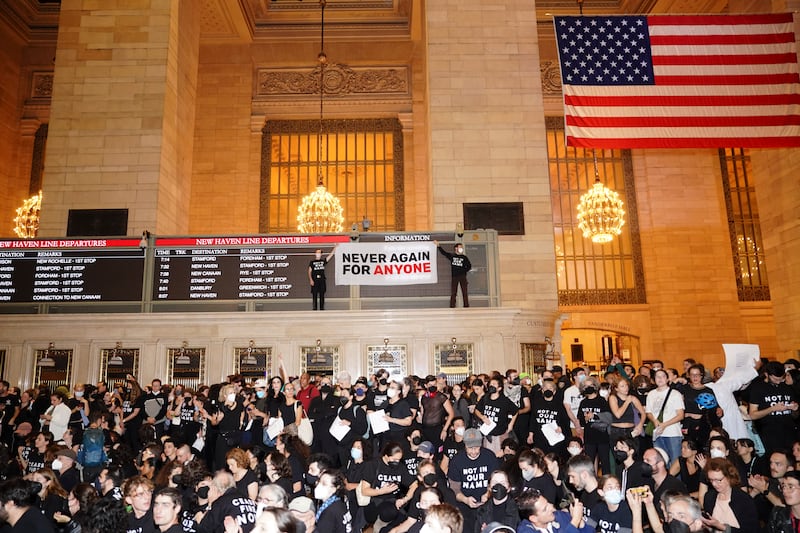In Tel Aviv on Saturday, Israeli prime minister Binyamin Netanyahu said the ground operation launched by Israeli troops in Gaza was the second stage of a war against Hamas that would be long and difficult.
Speaking at a news conference, he said every effort would be made to rescue the more than 200 hostages held by Hamas.
During the address, Mr Netanyahu conceded that regional rival Iran was not involved in planning the October 7th attack in which Israel claims 1,400 people were killed in attacks. But he added that Tehran funds Hamas.
The Israeli PM urged Gaza civilians to move to safer areas.
Israel-Hizbullah close to ceasefire deal, says Israel’s envoy to Washington
Bethlehem now ‘a Palestinian village subjected to intense intimidation, social starvation’, say church leaders
Latest Israeli air strikes on Gaza kill at least 28 people
Gaza: Five killed in Israeli air strike on house in Nuseirat refugee camp
Efforts to secure the release of more than 200 hostages will continue even during the ground offensive against Hamas in Gaza, said Mr Netanyahu. Asked at a news conference whether contacts to release the hostages would continue even during the ground offensive, Mr Netanyahu replied: “Yes.” He added that the assault could help in recovering hostages.
He said the idea of a swap deal of hostages for Palestinian prisoners had been discussed within the war cabinet but declined to elaborate, saying revealing any details would be counterproductive.
Mr Netanyahu also said Hamas was using hospitals in Gaza as command centres. And he added that the engagement with Hamas inside the Gaza Strip will be difficult and long. Moreover, he added, “after the war we will all have to answer difficult questions, that includes me”.
Meanwhile, Gaza’s besieged people had barely any communications with the outside world on Saturday as Israeli jets dropped more bombs and suggested a long-threatened ground offensive against Hamas militants running the Palestinian enclave was starting.
Israel said troops sent in on Friday night were still in the field whereas previously it had made only brief sorties during three weeks of bombing to destroy Hamas.
The country’s defence minister said “the ground shook in Gaza” and that the war against the territory’s Hamas rulers has entered a new stage.
This largely cut off the besieged enclave’s 2.3 million people from the world while enabling the Israeli military to control the narrative in a new stage of fighting.
The military released grainy images on Saturday showing tank columns moving slowly in open areas of Gaza, many apparently near the border, and said warplanes bombed dozens of Hamas tunnels and underground bunkers.
The underground sites are a key target in Israel’s campaign to crush the territory’s ruling group after its bloody incursion in Israel three weeks ago.
“We moved to the next stage in the war,” defence minister Yoav Gallant said in remarks broadcast on Saturday. “Last evening, the ground shook in Gaza. We attacked above ground and underground … The instructions to the forces are clear. The campaign will continue until further notice.”
His comments signalled the gradual ramping-up toward what is expected to evolve into an all-out ground offensive in northern Gaza.
Early in the war, Israel had already amassed hundreds of thousands of troops along the border. Until now, troops had conducted brief nightly ground incursions before returning to Israel.
The Palestinian death toll in Gaza on Saturday rose to just over 7,700 people since October 7th, with 377 deaths reported since late Friday, according to the territory’s health ministry.
[ ‘Anxiety’ racks Israeli hostage families as army assaults GazaOpens in new window ]
A majority of those killed have been women and children, the ministry said.
Ministry spokesman Ashraf al-Qidra told reporters the disruption of communications has “totally paralysed” the health network.
Across Gaza, terrified civilians were huddling in homes and shelters with food and water supplies running out. Electricity was knocked out by Israel in the early stages of the war.
More than 1.4 million people have fled their homes, nearly half crowding into UN schools and shelters.

Aid workers say the trickle of aid Israel has allowed to enter from Egypt in the past week is a tiny fraction of what is needed.
Gaza hospitals have been scrounging for fuel to run emergency generators that power incubators and other life-saving equipment.
The intensified air and ground campaign also raised new concerns about dozens of hostages dragged into Gaza on October 7th.
On Saturday, hundreds of relatives of hostages gathered in a square in downtown Tel Aviv, demanding to meet Israeli prime minister Benjamin Netanyahu and defence minister Mr Gallant. Some in the group demanded that Israel push for the release of all hostages before proceeding with the campaign against Hamas.
Mr Gallant later said he would meet the families on Sunday.
In Cairo, Egyptian president Abdel Fattah el-Sissi said his government was working to de-escalate the conflict through its talks with the warring parties to release prisoners and hostages.
The Israeli military said on Saturday it had killed the head of Hamas’s aerial wing, who had helped plan the October 7th attack by the Islamist group on Israel’s southern towns.
The Israeli Defence Forces said its fighter jets struck Asem Abu Rakaba, head of the Hamas Aerial Array, who was responsible for Hamas’ UAVs, drones, paragliders, aerial detection and aerial defence.
“He took part in planning the massacre in the communities surrounding the Gaza Strip on October 7th. He directed the terrorists who infiltrated Israel on paragliders and was responsible for the drone attacks on IDF posts,” the IDF said.
On Friday, the United Nations General Assembly overwhelmingly backed a resolution drafted by Arab states calling for an immediate humanitarian truce and demanded aid access to Gaza and protection of civilians.
While not binding, the resolution carries political weight, reflecting the global mood. It passed to a round of applause with 121 votes in favour, while 44 abstained and 14 — including Israel and the United States — voted no.

After Israel announced a step-up in operations, White House national security spokesman John Kirby said the US supported a pause in Israeli military activity in Gaza to get humanitarian aid, fuel and electricity to civilians there.
Mr Kirby would not comment on the expanded ground operation. But he said Washington supported Israel’s right to defend itself and added: “We’re not drawing red lines for Israel.”
He said that if getting more than 200 hostages abducted by Hamas out of Gaza required a localised temporary pause, the US supported that.
US defence secretary Lloyd Austin, in a call with Israeli defence minister Yoav Gallant, “underscored the importance of protecting civilians” during operations in Gaza, the Pentagon said on Friday.
[ As Israel-Hamas war escalates, dangers of Biden’s embrace become more apparentOpens in new window ]
Mark Regev, an adviser to Mr Netanyahu, told MSNBC that Israel was starting its payback against Hamas and “Gaza will feel our wrath tonight”.
Russian foreign minister Sergei Lavrov has said on Saturday that Israel’s bombardment of Gaza runs counter to international law and risks creating a catastrophe that could last decades.
Mr Lavrov made the comments, some of Moscow’s most critical of Israel yet, in an interview with the Belarusian state news agency Belta, which released them on Saturday.
“While we condemn terrorism, we categorically disagree that you can respond to terrorism by violating the norms of international humanitarian law … including hostages that have been taken,” said Mr Lavrov.
It was impossible, he added, to destroy Hamas — as Israel has vowed to do — without destroying Gaza along with most of its civilian population.
Concerns about the risk of a wider Middle East conflict have risen in recent days with the US dispatching more military assets to the region as Israel pummelled targets in Gaza and Hamas supporters in Lebanon and Syria.
[ US strikes Iran-linked targets in SyriaOpens in new window ]
Much of the infrastructure of Gaza, which has been living under blockade by Israel and Egypt since 2007, has been shattered by Israeli bombing. — AP/Reuters




